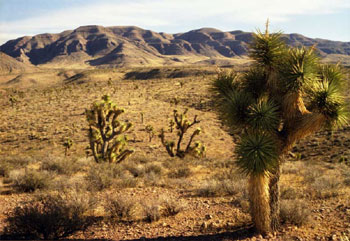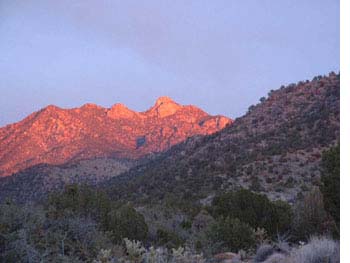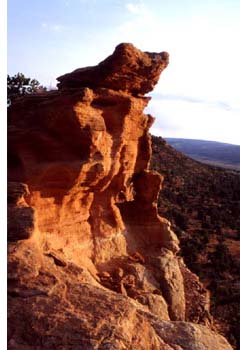
| Issue 1, Winter 2003 | ||||
Out of the Blue...Why Wilderness?
The most common question is: “Aren’t they already protected?”—and the answer is more complicated than many people think. Photo: Zach Crumbo Federal land management agencies like the National Park Service, the Bureau of Land Management, and the U.S. Forest Service must produce “resource management plans” to guide the staff on how to best protect the natural resources of that land area. These plans are revised every 15-20 years. Existing management guidelines—those that often define protective tenets for a park, monument, or forest—can be rewritten or eliminated during these revision processes. In addition, individual projects that could affect wild lands can be proposed and incorporated at any time. Often these include installation of power lines, campgrounds, visitor centers, rest areas, bike trails, or motorized vehicle trails. Administrations come and go, as do individual land managers. Some appreciate the conservation values of wild lands and providing opportunities for solitude and naturalness, but some do not. Decisions to build facilities or extract resources in wild areas are generally an irreversible reclassification of wilderness to its antithesis: civilization.
Photo: Jay Krienitz
Perhaps most important, wilderness offers a soothing elixir for the mistakes humans make—internally and externally—in our fast-developing world. Photo: Kim Crumbo Don Hoffman, the current Director of the AWC, is a retired Wilderness Program Manager with the U.S Forest Service. He spent a significant portion of his career managing and working in the Blue Range Primitive Area, one of the crown jewels of Arizona wilderness. |
||||
 I am often asked what additional protection wilderness adds to our national parks, monuments, and other special places.
I am often asked what additional protection wilderness adds to our national parks, monuments, and other special places.  Alas, unprotected, undesignated wild lands quietly await the eventual encroachment of development, the eventual proposal to construct or extract, the overexposure to misguided management, and the inevitable lapse in environmental vigilance where it passes from wild to developed—forever losing its value as a wilderness. And what is that value?
Alas, unprotected, undesignated wild lands quietly await the eventual encroachment of development, the eventual proposal to construct or extract, the overexposure to misguided management, and the inevitable lapse in environmental vigilance where it passes from wild to developed—forever losing its value as a wilderness. And what is that value? Short of congressional intervention, designated wilderness permanently allows land to function on its own primeval terms. It allows plants, mammals, and other creatures to exist in harmony with each other and perform their natural biological functions that help clean our water and air. Wilderness designation also helps citizens and land managers who don’t appreciate the value of wild lands to direct their ideas and energy to more appropriate places, where they will be met with less resistance.
Short of congressional intervention, designated wilderness permanently allows land to function on its own primeval terms. It allows plants, mammals, and other creatures to exist in harmony with each other and perform their natural biological functions that help clean our water and air. Wilderness designation also helps citizens and land managers who don’t appreciate the value of wild lands to direct their ideas and energy to more appropriate places, where they will be met with less resistance. 
 Make your late winter and early spring outdoor plans here! Visit our comprehensive list of day outings, inventory trips, meetings, and upcoming AWC events for the latest in wilderness “happenings” around the state.
Make your late winter and early spring outdoor plans here! Visit our comprehensive list of day outings, inventory trips, meetings, and upcoming AWC events for the latest in wilderness “happenings” around the state. 
